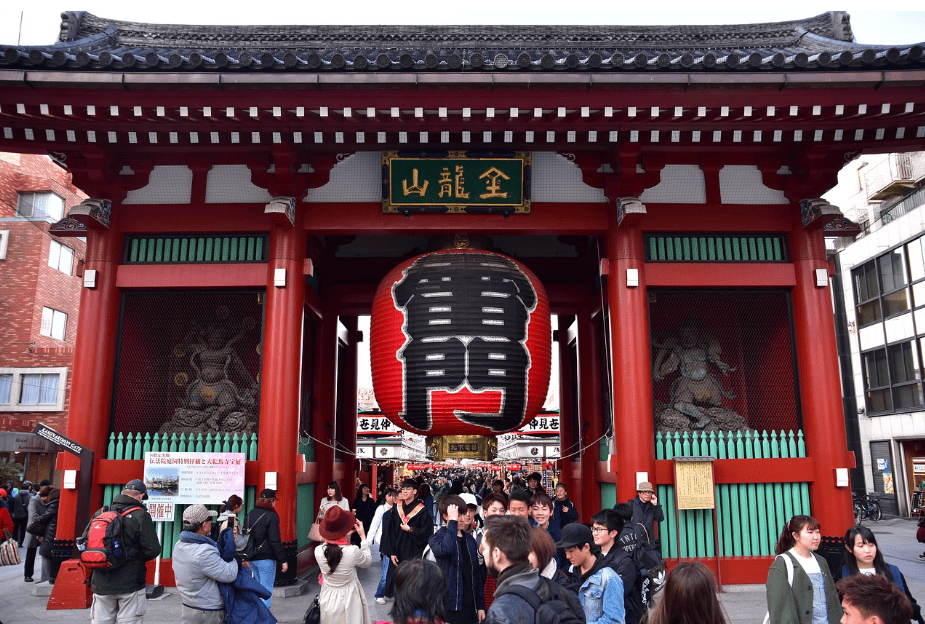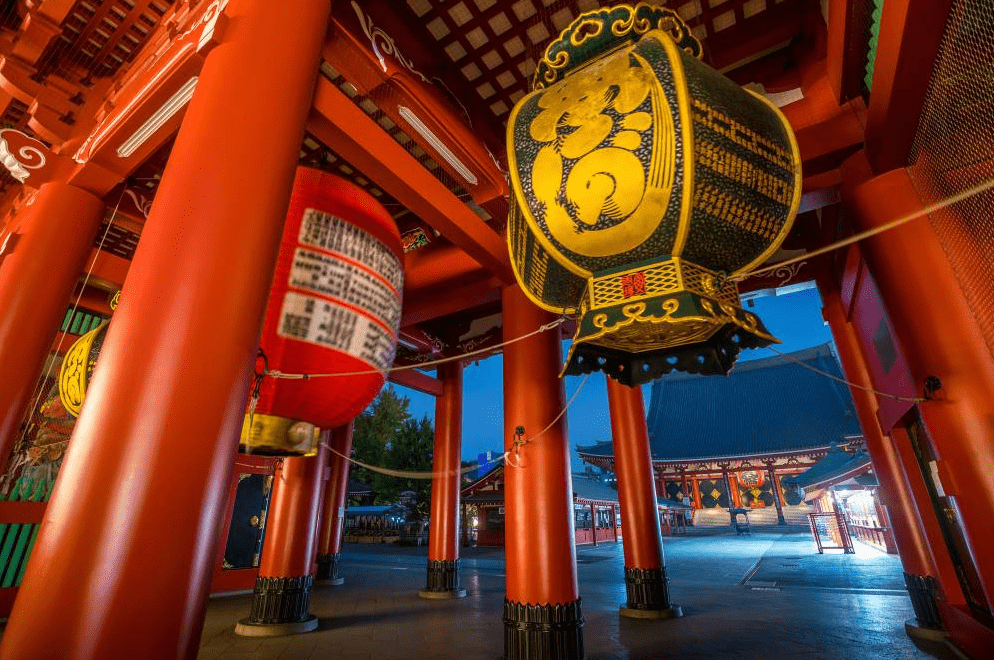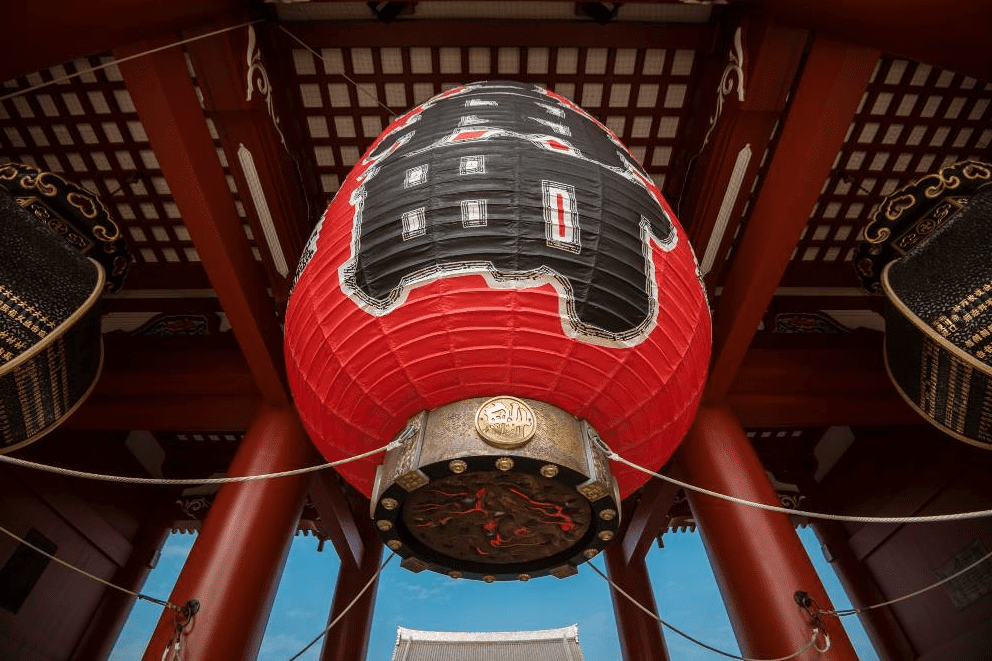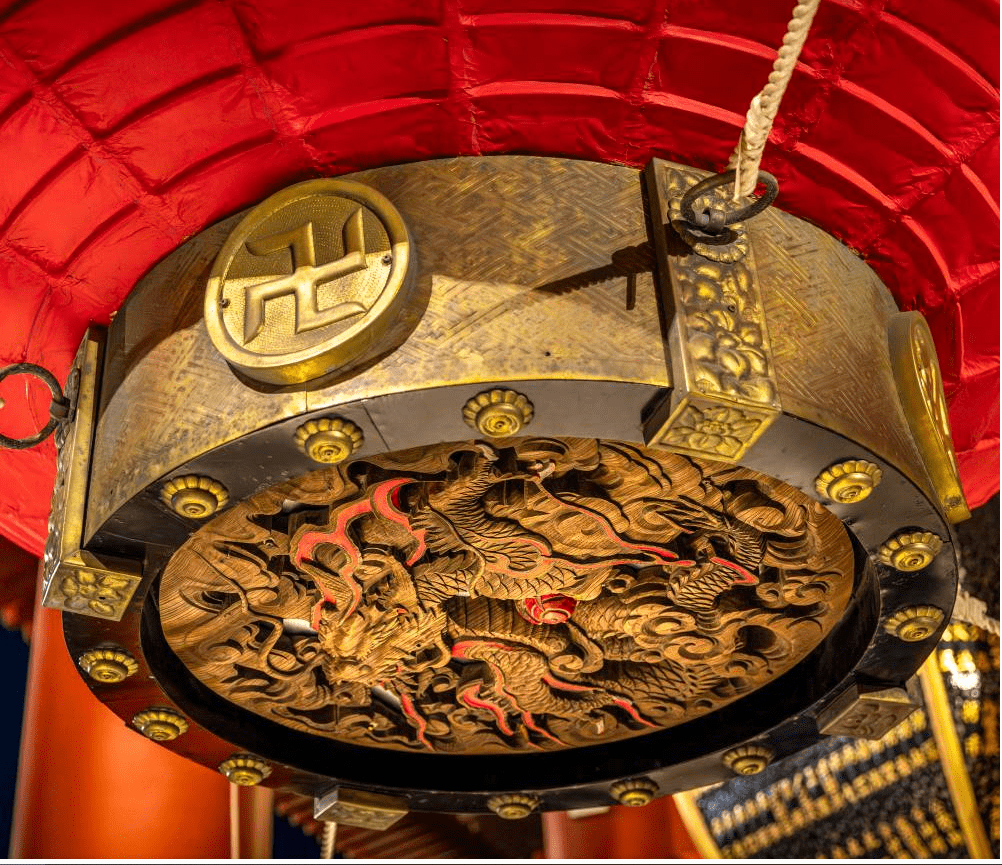Kaminarimon is one of the most iconic landmarks in Asakusa, Tokyo, blending history, culture, and spirituality in a single place. With its massive red lanterns, statues of deities, and grand architecture, Kaminarimon attracts thousands of visitors each year. Whether you’re there to pray, admire the architectural beauty, or simply soak in the atmosphere, Kaminarimon is a must-visit destination in Tokyo. Don’t miss the opportunity to visit Kaminarimon and experience the wonders it offers.
History of Kaminarimon

When visiting Asakusa in Tokyo, a must-see attraction is Kaminarimon, the grand gate that serves as the main entrance to Senso-ji Temple. Kaminarimon, also known as the “Thunder Gate,” is the outer of two large gates leading to Senso-ji Temple (the inner gate is called Hōzōmon). This gate is famous among tourists for its iconic giant red lantern and the deity statues flanking it. Standing at 11.7 meters high, 11.4 meters wide, and covering an area of 69.3 square meters, Kaminarimon is a grand sight.
Construction and Reconstruction
Kaminarimon was first built in 941 AD by Taira no Kinmasa, a military commander. Originally located near Komagata, the gate was relocated to its current location in 1635. At that time, the wind deity (Fūjin) and thunder deity (Raijin) statues were placed at the gate for the first time.
Over time, Kaminarimon suffered from numerous damages and fires. Four years after its relocation, the gate was completely destroyed by fire, and in 1649, Tokugawa Iemitsu rebuilt it along with several other main structures of the temple complex. The gate was destroyed again by fires in 1757 and 1865. The current Kaminarimon was dedicated in December 1960, after being rebuilt with a donation from Kōnosuke Matsushita, the founder of Matsushita Electric Industrial Company (now Panasonic).
Original Name of Kaminarimon
Although commonly known as Kaminarimon, the gate’s original name is Fujin Raijinmon. This name is derived from the statues on either side of the gate. “Fujin” is the god of wind, and “Raijin” is the god of thunder. The gate is named for the statues, with Fujin on the right and Raijin on the left. For ease of pronunciation, it is commonly referred to as Kaminarimon, meaning “Thunder Gate.”
Features of Kaminarimon

Deity Statues
Kaminarimon houses four deity statues: two in the front and two at the back of the gate. In the front, the Shinto deities Fūjin and Raijin are displayed. Fūjin, the god of wind, is on the east side of the gate, while Raijin, the god of thunder, is on the west. The original statues were severely damaged in the 1865 fire, with only their heads saved. These statues were restored for the 1960 reconstruction of the gate.
At the back of the gate, there are two additional statues: the Buddhist deities Tenryū on the east and Kinryū on the west. These statues were donated in 1978 to commemorate the 1350th anniversary of the first appearance of the bodhisattva Kannon (Avalokiteśvara) in Asakusa, which led to the establishment of Senso-ji Temple. The statues were carved by the master sculptor Hirakushi Denchū, who was 106 years old at the time.
Meaning and Symbolism of the Dragon Statues
Kinryū and Tenryū are dragon deities that guard water and protect Buddhist followers. In Senso-ji Temple, these dragon deities hold the same importance as Fūjin and Raijin. According to documents at Senso-ji, dragon deities are believed to guard humans from sea disasters and are also associated with rice cultivation.
At Senso-ji Temple, the dragon deities are also seen as protectors of Buddhism and Kaminarimon. This highlights the significant role of dragon deities in local culture and beliefs. At Kaminarimon, Tenryū and Kinryū are depicted as male and female, respectively. Although these dragon statues resemble humans, each has a tail, indicating their dragon nature.
Giant Red Lantern

Hanging in the center of the gate is a giant red lantern (chōchin). The lantern is 3.9 meters high, 3.3 meters wide, and weighs about 700 kilograms. The fifth iteration of the lantern was made by Takahashi Chōchin K.K in 2013, and it features a metal base similar to previous lanterns. The current iteration is the sixth. The base of the lantern bears a nameplate reading “Matsushita Denki,” the former name of Panasonic in Japanese, Matsushita Denki Sangyo Kabushiki Gaisha. The front of the lantern displays the name Kaminarimon (雷門), while the back shows the official name, Fūraijinmon (風雷神門). During festivals like Sanja Matsuri, the lantern is folded to allow tall objects to pass through the gate.
Materials and Production Process of the Lantern
The frame of the lantern is made from bamboo sourced from the Tanbo region in Kyoto. This bamboo was chosen for its strength and flexibility, making it ideal for lantern frames. The outer part of the lantern is wrapped with 300 sheets of Japanese paper made from mulberry trees produced in Fukui Prefecture. This mulberry paper is known for its strength and weather resistance, ensuring the lantern withstands various environmental conditions.
The lantern is produced by Takahashi Chochin, a renowned lantern-making shop located in Shimoku, Kyoto. The shop has a long history of traditional lantern-making and maintains high quality in all its products. Every ten years, the shop updates the giant Kaminarimon lantern to ensure it remains in excellent condition for future generations.
Unique Connection with Panasonic
The giant Kaminarimon lantern and Panasonic, a Japanese electronics company, have had a close relationship since 1960. At that time, Matsushita Konosuke, the founder of Matsushita Electric (now Panasonic), fell ill. He visited Asakusa Temple to pray for his recovery. After he recovered, as a token of gratitude, he donated a large gate and lantern to the temple, which became the Kaminarimon we know today.
This relationship continues to this day. Matsushita Konosuke’s name is inscribed below the giant lantern as a tribute to his contribution. This donation not only reflects the connection between an individual and a sacred place but also shows how history and tradition can be preserved through collaboration between the community and the private sector.
Dragon Carvings on the Lantern

When visiting Kaminarimon, be sure to look underneath the giant lantern. There, you’ll find dragon carvings with deep significance. While many people focus on the lantern’s size and beauty, the dragon carvings at the base are also worth noting.
An anecdote suggests that the dragon carvings symbolize the Dragon God illuminating a group of goldfish when a Buddha statue was caught in a net in the Sumida River. Therefore, the Dragon God is also considered one of the deities protecting Asakusa Temple. These carvings add historical and spiritual value to the giant Kaminarimon lantern.
Japanese people also believe that dragons living in the vast ocean can summon clouds and create rain. Asakusa, with its wooden buildings and fire risk, highly values dragons that bring rain and protect from fires. This is another interpretation of the dragon carvings under the giant Kaminarimon lantern.
Experience Visiting Kaminarimon

Visiting Kaminarimon offers a unique experience that blends history, culture, and spirituality. Before entering Senso-ji Temple, you’ll pass through Nakamise-dori, a shopping street filled with souvenir shops, traditional snacks, and various Japanese goods. The sensation of walking through Nakamise-dori towards Kaminarimon is unforgettable. The giant red lantern and deity statues at Kaminarimon create a majestic and sacred impression, making every step towards the temple more meaningful.
Admire the Architectural Beauty
Take time to appreciate the architectural beauty of Kaminarimon. The detailed carvings and deity statues on the gate reflect the skill and dedication of the craftsmen of the past. The gate is not just an entrance but also a symbol of protection and good fortune for visitors to Senso-ji Temple.
Discover Spiritual Meaning
For many visitors, Kaminarimon is not just a tourist attraction but a place to find spiritual meaning. Before entering Senso-ji Temple, many stop at Kaminarimon to pray and seek blessings. The deity statues at the gate are believed to provide protection and good fortune, making each visit to Kaminarimon a profound spiritual experience.
Events and Festivals
Kaminarimon is a focal point during various events and festivals held at Senso-ji Temple. One of the largest festivals is Sanja Matsuri, which attracts thousands of visitors each year. During this festival, the giant red lantern at Kaminarimon is folded to allow portable shrines (mikoshi) and other tall objects to pass through the gate. The festival brings vibrancy and joy to the Kaminarimon area, making it an excellent time to visit and experience local culture.

Is Testosterone a Steroid?
Testosterone vs. Steroids Explained
Newsletter Sign-up
Stay updated with the latest fitness trends,
workout tips, and health insights delivered straight to your inbox.
Subscribe now to unlock exclusive content and stay ahead of the game!
Want to shred fat like a pro athlete?
Whether you’re aiming for peak performance or just looking to get ripped, understanding the role of testosterone in your body is key to achieving your goals.
But is testosterone itself considered a steroid? Let’s dive into the details and clear up any confusion once and for
all.
Is Testosterone a Steroid? Testosterone vs. Steroids Explained
The question on many minds is whether testosterone, a hormone produced
by the body, is classified as a steroid. While both substances are often associated with muscle growth and performance enhancement, they’re
not the same. Let’s break it down.
What is testosterone?
Testosterone is a naturally occurring hormone in men that plays a crucial role
in muscle development, fat loss, and overall
health. It’s produced by the testes and adrenal
glands and is part of the body’s anabolic process—meaning it
helps build and repair tissues.
Where is testosterone produced?
Testosterone is primarily synthesized in the testes for men and in the ovaries
for women, although it can also be produced by the adrenal glands.
This explains why both men and women have
testosterone levels that vary throughout their lives.
Why do some men suffer low testosterone?
Low testosterone (hypogonadism) is a common condition that can lead
to symptoms like fatigue, reduced muscle mass, decreased libido, and mood changes.
It’s often due to factors like aging, poor lifestyle choices, or
underlying health conditions.
Is testosterone a steroid?
This is where things get tricky. While testosterone is a hormone, it’s not a steroid.
Steroids are a type of synthetic molecule designed to mimic the body’s natural hormones.
Anabolic steroids, for example, are man-made versions
of testosterone and other hormones intended to boost muscle growth and physical performance.
The real difference between testosterone and steroids
The key distinction is that testosterone is a naturally occurring hormone, whereas steroids are synthetic compounds.
Testosterone plays a vital role in maintaining health and well-being, while steroids are often used illicitly for their potent effects
on muscle growth and strength.
The dark side of anabolic steroid use
Abusing anabolic steroids can lead to serious health risks,
including liver damage, cardiovascular issues, psychological instability, and hormonal
imbalances. It’s important to recognize that natural hormone production is the safest and most effective way to achieve fitness goals.
Summary – Is testosterone a steroid?
In summary, testosterone is not a steroid but a hormone produced
by the body. While both substances can influence muscle growth and performance, they are fundamentally different in origin and function.
The number 1 supplement for men
Looking to get shredded like a pro athlete?
Try Supplement Name, the ultimate solution for fat loss and
muscle gain. Safe, effective, and backed by scientific research, it’s your key to unlocking your best body
ever!
Leave a comment
Have your say on the use of steroids versus natural hormone production. Share your thoughts on achieving fitness goals responsibly
in the comments below.
About Greatest Physiques
Your go-to source for everything fitness-related, from workout tips to nutrition advice
and health insights. We’re here to help you achieve your goals and live your
best life.
Subscribe to our Newsletter
Stay ahead with the latest updates, exclusive content, and expert advice straight to your inbox.
Subscribe now!
Feel free to surf to my website: top steroids online
70918248
References:
anabolic steroids deca (https://gitea.greyc3sa.net/abrahammartins)
70918248
References:
Military steroids – https://digitalbarker.com/employer/anavar-para-la-mujer,
It does present some caffeine and theacrine for a higher metabolic fee, though. It leans tougher into selling fats oxidation as opposed to boosting testosterone or accelerating muscle hypertrophy, which makes it significantly well-suited for women who are severe about slimming down. Long-term misuse can even result in hair loss, muscle loss, and different side effects which might be the precise reverse of what you’re working for. For muscle restoration, Deca-Durabolin (Nandrolone Decanoate) is a standout anabolic steroid. For a balanced, lean physique with added muscle hardness, Anavar is an excellent choice. And if joint pain is holding you back throughout your reduce, Deca-Durabolin can provide the help you should maintain pushing heavy weights. Whether you are aiming to bulk up, minimize down, or boost your athletic efficiency, having a clear plan ensures you maximize features whereas staying in charge of your progress.
Trenbolone may even suppress endogenous testosterone ranges, leading to male hypogonadism. However, trenbolone doesn’t induce aromatization, causing important elevations in blood pressure, which are attributed to huge reductions in HDL. Anadrol instantly stimulates estrogen receptors, inflicting noticeable amounts of extracellular fluid retention. For this reason, people primarily use Anadrol as an off-season bulking steroid. According to our powerlifting patients, Dianabol is among the most potent steroids for rising uncooked strength and power. Dr. John Bosley Ziegler formulated Dianabol with the intention of creating a compound more anabolic than testosterone but less androgenic.
In the tip, all this means better, quicker outcomes thanks to the wide-ranging results of Anavar. So, whereas these are two critical benefits of Anavar, they aren’t the only ones. Even if cutting is your primary reason for utilizing Anavar, you’ll get many other constructive results that may only add to your gains and general outcomes. Strength, endurance, stamina, and recovery are all enhanced with Anavar. Whereas Anavar is toxic to the liver5, as we would anticipate with an oral steroid, its hepatotoxicity level is minimal in contrast with many different steroids, making this a super choice for newbies. Anavar is a sort of oral steroids that I knew I’d be pretty comfortable taking back once I began all this. There is not any proof that steroids are any less efficient in older people than they’re in youthful people.
As with a regular steroid cycle, the compound that you just use will largely come right down to the benefits you want to acquire from it. A bridge takes place in the time between the end of one cycle and the start of the next and is utilized to assist maintain the muscle mass gained through the cycle. Winstrol is used at 10mg every day for this 6-week cycle, whereas Clenbuterol is strategically taken through the preliminary and last 2 weeks to prevent a reduction in effectiveness.
They offer the strength and efficiency positive aspects you’re after, minus the problems of artificial hormones or dangerous injections. It’s formulated utilizing natural components that don’t interfere along with your body’s hormone manufacturing or trigger liver toxicity. There’s no need for PCT, and you won’t experience hair loss, acne, or shutdown such as you might with synthetic steroids. Fats loss continues to be likely to occur for girls (unless your diet is very calorie-heavy). The fat loss combined with lean positive aspects can lead to an general achieve in physique weight, but importantly, it shouldn’t be water weight, and the features must be all muscle. Enhanced muscular definition is possible after a single Anavar cycle for girls, even at decrease doses of 10mg. In all however the most excessive circumstances, ladies wanting to achieve most leanness will concentrate on getting to 10%-15% physique fats.
Are you looking for a secure and authorized various to anabolic steroids that can help you with your chopping cycle? Cutting cycles require cautious consideration to your food plan and train program, and adding the proper supplement is vital to getting the results you need. When planning a slicing steroid cycle, think about factors like experience, objectives, tolerance of unwanted side effects, price range, and authorized concerns.
There are several effective and legal alternatives that offer comparable results with fewer dangers. One such option is Selective Androgen Receptor Modulators (SARMs)—compounds that selectively goal muscle and bone tissue with out the systemic effects of anabolic steroids. SARMs like Ostarine (MK-2866) and Ligandrol (LGD-4033) are increasingly popular for muscle retention and fat loss. While extra research is required, early research counsel SARMs can provide anabolic benefits with decrease androgenic unwanted effects (Basaria, 2010). One of the main benefits of Winsol is its capacity to extend muscle hardness and vascularity, which creates a extra outlined and ripped look. It also helps to enhance energy and endurance, making it easier to power through powerful exercises.
If users stop lifting weights and expertise muscle atrophy, should they resume training sooner or later, the body will restore the earlier muscle dimension in a matter of weeks. Oral steroids stimulate hepatic lipase within the liver, further decreasing high-density lipoprotein (HDL) cholesterol and thus exacerbating blood stress. The aromatizing nature of Dianabol also causes water retention, which increases blood viscosity, decreasing circulation to the heart. Bodybuilders in our clinic sometimes gain 25–30 kilos of weight during their first Dianabol cycle, with roughly two-thirds of this being lean muscle and the remaining being water retention. Cutting is crucial for athletes, bodybuilders, and fitness enthusiasts, because it reveals muscle definition, striations, and vascularity—all of which are sometimes hidden beneath a layer of fat.
Faux Primobolan will typically be Masteron or, in some instances, Testosterone propionate, being sold as Primobolan. Your outcomes and unwanted aspect effects will differ, and this is often the one way somebody suspects they’ve been scammed with a fake product. If your Primo turns out to be Masteron, and you didn’t get it examined before using it?
These supplements come in the form of pure drugs and are designed to provide comparable benefits with out the worry of adverse unwanted effects. Winsol from CrazyBulk has been found to have a variety of benefits for athletes and bodybuilders looking to enhance their physiques. Those with more expertise could select stronger steroids like Dianabol for quicker muscle achieve. Selecting a cycle that matches one’s expertise can help meet well being goals and reduce side effects.
References:
steroids|2ahukewjy0cqyv7hnahvpes0khayodxuq4lyoahoecaeqfq – https://www.stadt-berga.de/wp-content/pgs/dianabol_kaufen_1.html –
70918248
References:
https://www.golfavenida.com/noticias-golf-coronavirus
70918248
References:
gnc anabolic steroids – https://www.1proff.ru/sale/maski/filter/clear/apply/?SHOWALL_2=1&%3BSHOWALL_2=1&%3Bamp%3Bamp%3Bamp%3Bamp%3Bper_page=40 –
70918248
References:
https://fromsophiawithgrace.com/2022/06/09/keto-and-paleo-friendly-scallops-on-the-bed-made-of-red-bell-pepper-with-the-salad-made-of-marinated-fennel/
70918248
References:
natural bodybuilding vs steroid (http://mediterranealg.it/index.php/en/component/k2/item/38-long-and-big-title-comes-here)
70918248
References:
https://alfaisalengineering.com/understanding-electrical-codes-a-homeowners-guide/
70918248
References:
https://mendozanews.com.ar/impactante-revelacion-del-dr-marcelo-straniero-acerca-de-la-contaminacion-y-el-deporte/
70918248
References:
Tabactivity android (https://boshcornerstone.org/emergency-electrical-repairs-what-to-do-before-the-pros-arrive/)